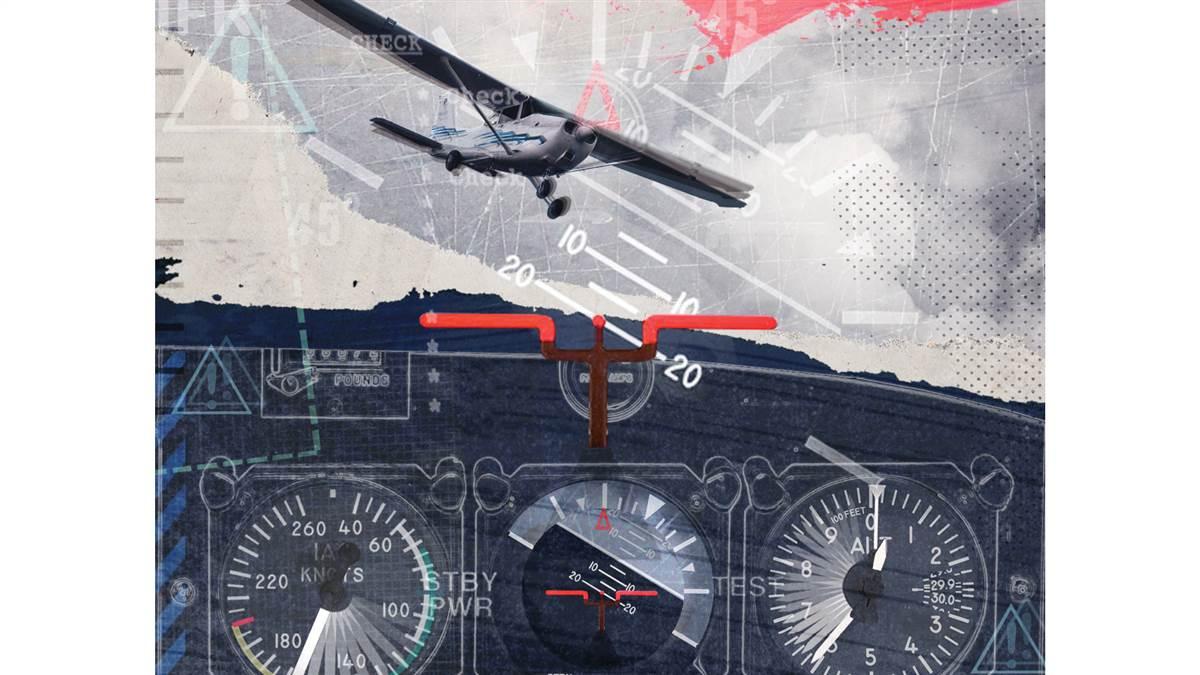Out of control
Keeping the shiny side up

Illustration by Sarah Hanson
So, it was no surprise to see that I was on the gauges just a few seconds after takeoff. Power set, on heading, climbing to the 3,000-foot altitude assigned in my clearance, and a left turn was coming up. What came next was a shock.
For some reason I took my scan away from the panel for a second or two to check some long-forgotten item that must have seemed very important at the time. Maybe it was to look at a chart, or load an upcoming frequency, or make sure that the transponder was on. The reason doesn’t really matter. What did matter was that when I went back on the gauges, I instantly learned the airplane was in a steep bank, with its nose aimed well below the horizon. It was a classic nose-low type of unusual attitude.
For those who wonder if all that practice recovering from unusual attitudes during training pays off when faced with the real thing, I can assure you that it did in this case. I followed the nose-low unusual attitude recovery per the textbook: power back, roll wings level, then raise the nose to a level pitch setting. All of this in the face of a pretty stressful situation, and close to the ground, to boot.
The other type of unusual attitude is of the nose-high variety. The nose is pointed abnormally high, airspeed is bleeding off, and the attitude indicator’s sky pointer is indicating a 45-degree—or greater—bank angle. To recover, add power, lower the nose, and then roll wings level.
It helps to review the reasons behind the order of these recovery steps. In the nose-low unusual attitude power is reduced first, to prevent airspeed from blowing through—or beyond—the airspeed indicator’s yellow arc. Next, the wings are leveled to prevent any spiraling tendency during the final step—the gradual pull-up to a level pitch attitude. Pulling up while banked can increase overbanking and tighten an already-wild turn into what some call a “graveyard spiral”—and increase stress on the wings. The pull-up can require substantial aft-stick pressure, so wings-level is the rule.
With nose-high recoveries, the first step—increasing power while lowering the nose—is to prevent a stall. This maneuver may look daring as you slice downward with wings banked, but there’s no danger of overstressing the airframe in this condition. The main thing is to avoid the stall; moreover, applying aileron pressure at a low airspeed can raise the risk of one wing stalling before the other, and setting up a spiral or spin entry. The last step—leveling the wings—should only be done once a safe airspeed has been restored.
You say you’re flying partial panel with round gauges? Here’s a tip worth remembering: You can tell the nose is on the horizon the moment the airspeed indicator stops increasing (in nose-low situations) or decreasing (nose-high unusual attitudes).
Sometimes it seems the emphasis is more on recovery than prevention. Unusual attitudes can come about for a whole raft of reasons. Distraction can do it, as we’ve seen. A bad instrument scan, or fixating on one instrument can be another. A botched maneuver can kick off an unusual attitude, as can turbulence, a mistrimmed airplane, a pitch trim runaway, an avionics malfunction, or, of course, a lack of proficiency in partial panel flying.
Modern avionics displays, with their wide screens, multiple visual cues, and synthetic vision, can be a huge help in preventing unusual attitudes. So can autopilots integrated with airspeed, heading, navigation, and altitude functions. There’s a good reason why jets certified for flight by a single pilot are required to have an operating autopilot aboard. Things happen fast, and it can be easy for pilots to become task-saturated in high-workload segments of flight. The procedural guidelines for some jets allow the pilot to engage the autopilot after reaching a prescribed altitude after takeoff. For example, in the Embraer Phenom 300, with both engines running, you can engage the autopilot at 600 feet agl; on a single engine, it’s 1,000 feet agl. Autopilot inop? That’s a no-go item.
So, if you have an autopilot, use it. Autopilots are valuable safety tools that help us negotiate complicated procedures and improve our situational awareness. Gone are the days when autopilots were considered crutches for inept pilots. That said, it’s important to remain proficient in hand-flying. Besides, if you’re up to speed on hand-flying in instrument conditions you’re less likely to enter an unusual attitude in the first place.



